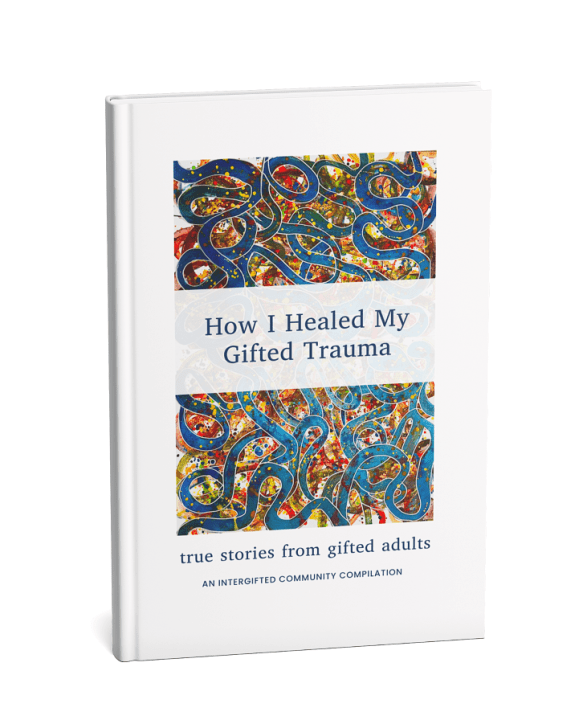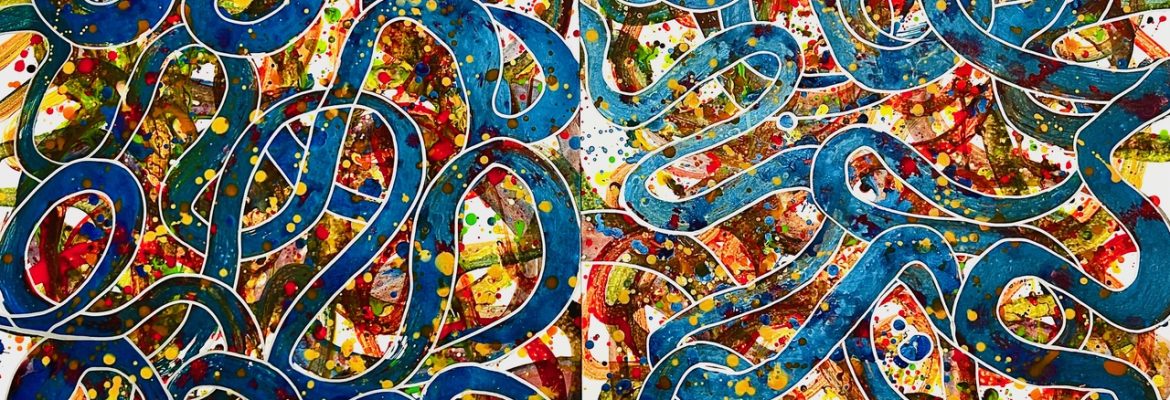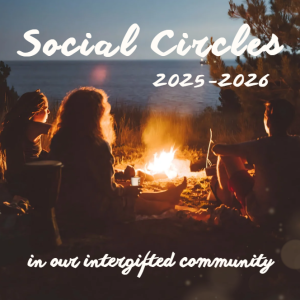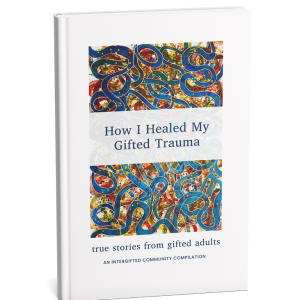Giftedness itself isn’t traumatizing, but the environments we grow up and live in often are. Because giftedness comes with unique developmental needs, sensitivities and social differences, it also carries particular vulnerabilities – especially in environments that misunderstand, minimize or exploit those differences. The resulting trauma can fracture our relationship with our gifted self, leaving us disconnected from our creativity, meaning and sense of existential belonging. In this article, Jennifer Harvey Sallin explores the nature of gifted trauma and what it means to heal it, by learning to create the conditions where it can be safely reclaimed. This article is an adapted version of the introduction to our recently published book How I Healed My Gifted Trauma, a collaborative exploration of how gifted people around the world are finding their way back to wholeness.
Fractures in gifted development
Childhood trauma affects children, but being a child itself isn’t traumatizing. Similarly, gifted trauma affects gifted people, but being gifted itself isn’t traumatizing.
The characteristics and environmental considerations of being a child – being small, young, not fully intellectually, emotionally or spiritually formed, often defenseless, unable to adequately care for and provide for oneself, and reliant on other people for basic survival and developmental nourishment and protection – make childhood trauma what it is: an ongoing fracture in the development of a coherent self caused by lasting shock, betrayal, abuse, neglect or other hardship that resilience alone wasn’t enough to withstand.
Likewise, the intellectual and other complexity outlier aspects of a gifted person, the social differences, the neuronormative environments we may live in, the unusual needs, make gifted trauma what it is: an ongoing fracture in a gifted person’s development and integration of the gifted aspects of self due to lasting shock, betrayal, abuse, neglect or other hardship that affects our capacity to accept, understand, embody and express our gifted qualities.
You might guess then that the two can, and often do, co-occur. There are many developmental environments (families, schools, religions, communities) which have reasons to be ignorant of, neglectful to, resistant to, or even hostile, exploitative or predatory to giftedness and a gifted person’s unique needs. The gifted child is working through general development and gifted-specific development at the same time, and both areas of the self are at risk for their own respective reasons.
A tangle of wounds
Really, this applies to many aspects of self-development: gender, culture, other neurodivergences. They can all get mixed up together in a big tangle of threads of identity wounding that are hard to distinguish. Sometimes, gifted girls are more prone to certain traumas due to the intersection of their giftedness and femaleness. Add “Black” or “autistic” or “gay”, for example, to that description, especially in certain places and cultures, and you can imagine the additional threads of wounding that might be tied into one’s self-development. These are just a few of the myriad identities and unique traits that can combine to make us susceptible to experiencing particular kinds of trauma.
But all our identities and traits also bring us rich possibilities and potentialities for unique trajectories of growth, embodiment, connection, creativity, generativity and existential belonging. It can sometimes be tempting to curse the aspects of self that made us vulnerable to trauma. How many times have I heard gifted people tell me, with utter certainty, that their giftedness is a curse, a poisoned gift they wish they could give back? How many times in my own life did I feel that way? More than I can count.
Many of us also cursed being a child – being weak and needy, because of the way it made us open to wounding by the people and environments we relied on. But just as we can’t skip childhood, we also can’t give our giftedness back. And when we can fully embrace the fact that there are aspects of our lives which are innate and required, and that those aspects can develop wonderfully or painfully or a mix of the two – depending on our environments and choices – our relationship to all our threads of identity changes.
Re-establishing loving contact
We start to care about all those aspects, to want to know how to love them. We spend less time cursing the vulnerable parts of ourselves and the people who wounded them, and more time learning the skills to tend to the wounds. We rebuild an environment where those parts of us don’t have to be hurt, but rather can be cherished and protected, and incorporated into the complex beauty of the imperfect life we live.
Sometimes people ask me, “Is my giftedness still alive? I feel like I’ve been hiding it away for so long, that I’m not even sure it exists anymore”. Yes, your giftedness is still alive, no matter how and when it learned to hide. And there are ways to re-establish loving contact with that part of yourself.
Or perhaps you haven’t been wounded to the extent that you feel your giftedness might no longer exist. Perhaps it’s “just” that you mask certain parts of your giftedness that feel overwhelming, or overinflate parts of your giftedness to conceal deep fears of not being enough. Whatever it is, there is a path for reconnection and rebalancing. It’s a path that allows you to get back in touch with the wholeness of who you are, no parts left out. And it’s a path that restores your creativity and existential meaning, which are essential parts of being alive that trauma often truncates. If I can’t fully access my giftedness, or if I’m manipulating it to cover for wounds (i.e. through hyperperforming), how can I be truly creative and existentially present with it?
Restoring wholeness
Creativity and existential presence allow us to self-lead, to know who we are, to align to our values and to look at life as a participatory emergence, rather than a judging, scary, punitive or competitive zero-sum game. When this presence comes back into loving contact with our giftedness, we have the chance to experience our gifted traits as unique ways of being in the world – ones that color, animate and build our life experience moment by moment. We restore agency, self-respect and dignity in living out and expressing our differences.
This obviously requires a dedicated investment in mastering the skills of creating safety for ourselves, stabilizing our environments, deep self-listening, embracing radical honesty, self-compassion, and being willing to integrate all the threads of our life into our existential meaning. It’s not always easy work, not work we can usually do alone in our own minds without any help from others, and not always a linear path. But it is work that is worth our efforts.
In the end, we get access to the wholeness that was fractured in the first place, when we were less safe, resilient and resourced than we are today. I say, “than we are today”, because if you’re exploring these themes, it means you have developed relatively more safety and possibility for your healing, and likely more potential resources for supporting you on the journey.
Outside-in, Inside-out
When I started in the gifted-specific support field, almost no one was talking about “gifted trauma”. I created a podcast to explore what it is, just to get some preliminary information out there that people could recognize themselves in and use to begin healing their own wounds. Since then, I’ve learned a lot more about trauma healing through various trainings and through my own trauma healing work, which has in turn deepened my understanding of gifted-specific trauma and how to heal it.
Gifted trauma can happen at home, at school, in the community, inside your own head and heart, to your soul and the essence of your being. It is not only an outside-in thing, it can also be an inside-out thing, and often it goes both ways in a complex dance. You can have all these various kinds of gifted trauma blending together into a big mix of things that no longer feel separable or like they originate from distinct life experiences.
One part of gifted trauma which is particularly difficult to process is that it happens specifically to our intellectual curiosity and drive – a quality which is rather intangible to the outside, and sometimes ephemeral even to us who possess those inner “gifted energies”. We end up with a formless, nameless jumble of wounds that the very mind that is wounded cannot then clearly analyze and understand.
This can lead us to overfocusing on problems we can solve, the ones “out there”: those problems of the world, the systemic threats, the workplace dynamics, the dysfunctional families, the philosophical puzzles and dilemmas, the physics or mathematical conundrums. Maybe if we can explain everything out there, the in here will feel safe again. Or maybe, we just stop caring or wanting to feel the in here altogether. Maybe we want to feel it, but just don’t know how.
It's a big personal step for us to reattune our intellectual attention to our own wounds, given that in gifted trauma, those wounds are to our intellect. Sometimes we just want to shout to the world, “Don’t force me to fix my wounded mind with my wounded mind!” It’s not really fair – something like asking a surgeon whose hands you’ve just disfigured to do surgery on those very hands with those very hands. Not to say our intellect is disfigured, exactly, but hurt, temporarily fragmented, and in pain at the least. In any case, in no position to be “fixing itself”.
That’s the value of community and education around giftedness and healing gifted-related wounds. Raising awareness and connecting minds on this theme serves as a balm, as encouragement, and as a reminder of our wholeness. This then serves as the “glue” or the gravity that allows the fragmented parts of our intellect to come back together, reconnecting inner wound with inner healer, in community and with support. No self-surgery when we’re needing first aid.
Phases of healing
The now-famous healing phases of Safety and Stabilization, Remembrance and Mourning, and Reconnection and Integration thus apply to gifted-specific trauma healing. Though they’re not exactly linear and can cycle through at various times, in various orders and for ongoing developments in our lives, these phases are usually presented in this general order.
Safety and Stabilization
To establish the safety and trust we need, we have to find and co-create an internal and external environment where giftedness as a concept, and our giftedness included, is not a threat. These environments do not pathologize, minimize or overinflate intellectual intensity, complexity and sensitivity. Masking is no longer needed, and our unique way of thinking and feeling is welcomed and mirrored. Here, external dysfunction does not impinge upon our capacity to be with ourselves long enough to get to know our authentic mind’s existential longing, and its unique calling and purpose for this life.
These environments allow us to recognize when we’re unconsciously bracing for rejection, exploitation, neglect, bullying or excessive demands relating to our gifted traits. They give space for our gifted mind and our nervous system to start to feel safe while being authentic. Our gifted self thus begins to experience a sort of solidity, stability and continuity that, due to traumatic fragmentation, it has not previously known.
Remembrance and Mourning
In that safety and stability, we start the work of remembrance and mourning. Here we mindfully face and grieve the truth of what we’ve experienced and the consequences it has had, and continues to have, in our minds and lives. We do this by consciously and tenderly revisiting formative experiences of deep misattunement, forced conformity, profound loneliness, the pain of injustice, broken boundaries and chronically unmet gifted needs – including the mind-fragmentation we’ve lived with in the wake of those experiences.
Grief and mourning are ways our brains learn. They give space for our minds to re-map reality, to see the terrain we’ve walked and how we’ve gotten here. They help us to honestly assess what matters most as we continue to walk on the path that life has landed us in at present. It is a Dabrowskian process, really: one of reassessment of where we have been that allows us to claim where we want to go from here.
We’re remembering and mourning in an empowered way. We are facing pain – deep pain, and sometimes even horror – true. But this can be done by connecting the pain to our unique life’s purpose and therefore understanding the pain’s value. Safety and stabilization are prerequisites to this process, preventing us from processing our pain in a disempowered way: disconnecting it from our unique life’s purpose and therefore believing that the pain has no meaning and was only a form of cruel, arbitrary torture that we somehow have to excise from our being. They also keep us grounded in the process, and deter us from the traps of toxic positivity, as well as psychological or spiritual bypassing – trying to deny or disconnect from the darkness of what we’ve been through by claiming only the light.
Metabolizing the darkness through remembrance and mourning is a commitment to the art of alchemy and a reclamation of the dignity of our unique journey and our very being. In that sense, it is an affirmation that our story is not over, and what was done to us did not in any way touch the fundamental existential value of our mind or our existence. It gave us certain conditions in which to struggle, grow and become, and those conditions have contained a certain kind of adversity linked to our gifted mind. Other people have other kinds of adversity in which they struggle, grow and become. This is our version, and it is dignified.
This phase gives us words and reassurances for the pain we experienced when our gifted minds were not met with respect, kindness, care and humanity – on the interpersonal level, intrapersonal level and systemic level. Here we get to recognize the cultural, religious, political or familial and intergenerational frameworks that somehow turned our giftedness, or parts of it, into an existential threat or burden.
Through this deepening contextual understanding, we see that our fragmentation and trauma wasn’t just ours to carry alone. It was happening because of so many complex layers of systemic movement that created pain for many, over such a time scale that our own story takes on a newer, more embedded tone. Our grief and mourning spread out in the process of reconnecting us to the struggle, growing and becoming of families, groups, communities, collectives and generations. In this way, our own alchemical process itself becomes systemic.
Reconnection and Integration
This brings us to the reconnection phase, in which we integrate and fully reclaim our selfhood, not just by naming the fragmentation but by also naming the wholeness explicitly. Here we actively rebuild trust in our gifted mind and perception, coming home to our own giftedness as a profound existential orientation – part of our soul’s unique signature and purpose. In that, we reclaim joy in our complexity and intensity, using our values and core selfhood as a compass on the path of struggle, growth and becoming. We form new relationships and reshape old ones to attune to the unique person we are, with intentionality, conscious engagement and healthy authenticity.
Life does not become perfect. It never has been and never will be for anyone or anything at any time. That’s not the reason we’re here. We’re here to experience variety and to creatively engage with that variety. Life gave us the variety of this very rare mind. That’s going to make our lives complexly different for as long as we live.
That unique variety can become a source of existential purpose, and the experiences – both the positive and negative ones – we go through because of our mind, shape that existential purpose constantly. We’ll all continue to go through adversity. But when we know how to tune into safety, how to grieve, and how to rebuild again and again and again, we look at adversity differently. And when we’ve had other gifted people’s support and care while going through these phases, we know that no matter what, we’re not alone and we don’t have to heal our wounded minds on our own, now or at any time in the future.
Gifted resonance
We were meant to resonate with our world. Gifted resonance offers us that very special welcoming of a certain variety of our experience that is very rare, and helps us to know that our gifted mind is welcome in its wholeness. That’s a perennial inspiration for us to grow toward our wholeness and discover the paths that lead there. There’s the overrun phrase of the journey being more important than the destination. I’d add that who joins you on the journey makes all the difference for how you travel your path.
In our recent writing and art compilation, How I Healed My Gifted Trauma, members of our community bring together the themes of uniqueness, adversity, purpose, meaning and belonging in an artful journey of living, learning and growing. We explore this artful journey through words and images, telling our individual stories of healing, and gathering together in a story of collective gifted healing. Through our sharing, you'll see how we all emerge stronger when we go through gifted healing together.
If you've been exploring your own gifted vulnerabilities and wounds, or those of a gifted person you love or care about in your life, our book will be a companion and a guide. As you travel alongside our writers and artmakers, our words and images may show you some things in your landscape you hadn’t noticed before.
Perhaps we'll point out some landmarks, or offer you a hand in a moment of struggle. Maybe we’ll walk ahead for you when you’re feeling unsure, because we've been where you’re going and fear the territory less now. We'll show you that it’s safe for you to continue on.
We may be a sun in the sky of your landscape, alighting your surroundings by day, or a moon at night, helping you rest. We can be the wind that will whisper to you and provide gentle calm. We will be rain in your desert, and sometimes a conversation partner, fulfilling needs that have long gone unmet.
In whatever way we meet you, one thing is clear: we believe that you too, like us, are whole. We are all finding our way back to that reality together, in whatever unusual way our gifted self approaches the universal journey of becoming who we each deserve to be: uniquely ourselves, belonging as an unalterable reality, to the experience of life together.
Resources
You can order How I Healed My Gifted Trauma at our bookshop!

Additional resources on gifted trauma can be found at my podcast Conversations on Gifted Trauma and Patty Gently's book Intersection of Intensity: Exploring Giftedness & Trauma. To learn more about the phases of trauma healing I've described in this article, you can look into the work of Judith Herman, especially her book Trauma and Healing.
Title illustration thanks to Lil Jedynak, co-editor of How I Healed My Gifted Trauma.

About Jennifer Harvey Sallin
Jennifer is the founding director of InterGifted. She's a psychologist, coach and mentor who specializes in providing training for coaches, therapists and other helping professionals who support the gifted population. She also performs giftedness assessments and writes extensively on giftedness and self-development. You can find her articles here on InterGifted’s blog and on her own blog at Rediscovering Yourself. Her climate psychology project is at I Heart Earth. She is based in Switzerland and works with gifted adults throughout the world. You can learn more about her here.










Melissa Lawrence
I stumbled across this article after what felt like my hundred and fiftieth argument with ChatGPT. Begging AI for Answers. Demanding that there had to be someone out there that could help me. That, I wasn’t the only one. That somewhere there was another really smart, funny, gifted, passionate, empathetic girl who is exhausted and stuck ’cause….life. A girl who has been hiding for 50 years. A lonely girl that needs to find a way out; out from underneath these suffocating wet blankets that all of these masks, that she has worn for so long, have become.
I see HOPE in this article. Thank you
….HYPER-FOCUSED DEEP DIVE INITIATED…..